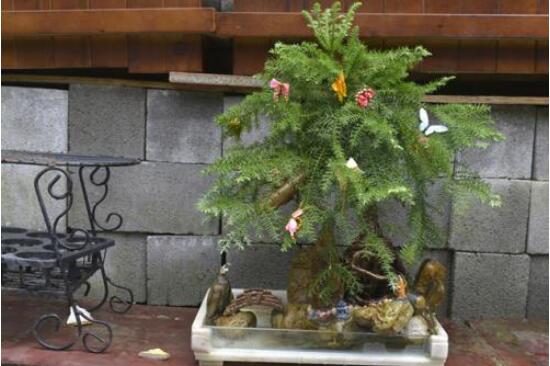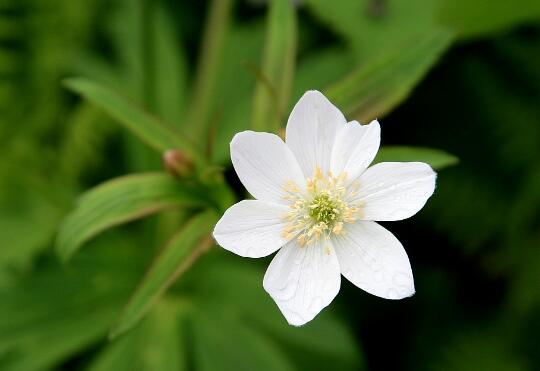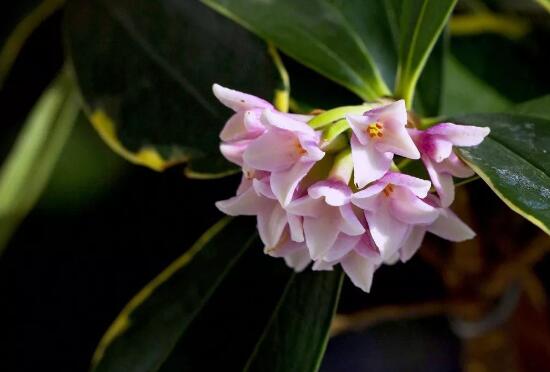How to propagate Australian fir, two propagation methods of Australian fir (cutting / sowing)
Australian fir, I believe flower friends know it, it is an evergreen tree, often used as a bonsai for people to watch, is one of the world's three major ornamental trees. Nowadays, more and more people are starting to raise Australian fir, but it must be more fun to breed it yourself than to buy it. So, how do Australian fir reproduce? Next, let's take a look at the breeding methods of Australian fir.
How do Australian fir propagate, cuttage / sow

There are generally two propagation methods of Australian fir: cutting and sowing. Among them, cutting refers to cutting a strong branch from the Australian fir and then inserting it into the culture soil; sowing refers to sowing the seeds of the Australian fir on the soil and curing after covering the soil. It sounds very simple, but it is a little difficult to do. Let's move on to the specific operation.
2. Two propagation methods of Australian fir (1) Cuttage propagation of Australian fir
1. Cutting time
The most suitable growth temperature of Australian fir is 10-25 ℃, so cutting should be carried out in May in spring or October in autumn, when the branch activity is high, and it is easier to root after cutting.
2. Cuttings selection
On the potted Australian fir, cut a strong branch and take the first 2-3 nodes as cuttings. Then remove the leaves from the cuttings and soak them in clean water overnight for cutting.
Note: when selecting cuttings, do not choose the main shaft or long branches as cuttings, otherwise it is easy to cause the crown shape of the plant is not correct, can only grow horizontally, affecting the value of ornamental.
3. Cutting substrate
According to the growth habits of Australian fir, we should choose coarse sand or vermiculite as the slotting bed, which has a good drainage function.
4. Cuttings start
Cutting propagation of Australian fir, do the above preparatory work, can officially begin. Insert the cuttings into the sand bed to maintain a growth environment of 20-25 ℃. In addition, it should be given enough water to maintain high air humidity. After doing so, generally 3 months after insertion can take root, and then can be transplanted, and then in accordance with the Australian fir culture methods to maintain.
(2) sowing and propagation of Australian fir
How do Australian fir propagate? Sowing is better than cutting, because the seedlings produced by sowing are stronger and stronger, and grow more vigorously. However, sowing propagation is more suitable for batch propagation, and indoor propagation is more suitable for cutting. The specific sowing methods are as follows:
From July to August, take the seeds of Australian fir and break the seed coat to promote it to take root and sprout. Then sow the seeds on the sand bed and cover it with 2 centimeters of fine sand. After that, keep the temperature at 20-25 ℃ and have a high humidity. After doing so, it will germinate in about 2-3 weeks and be planted immediately after germination.
Generally speaking, whether cutting or sowing, Australian fir can take root and survive, but the cuttings have the highest survival rate and are the most suitable for indoor propagation. Of course, the method is dead, people are alive, we can according to the actual situation, choose the method to breed. With regard to the breeding methods of Australian fir, the editor has introduced this, hoping to give you some help.
The propagation method of Australian fir mainly depends on seeds, but cuttings can also reproduce offspring. The main results are as follows: 1. The seedlings cultivated by sowing are strong and vigorous, so they are suitable for mass propagation. Generally from July to August, the newly collected seeds will first break the seed coat in order to promote germination, otherwise leaving the soil for a long time will easily cause the seeds to rot, and then sow the treated seeds in the sand bed, covering about 1.5 cm of fine sand. Under the condition of 25-28 ℃ and a certain humidity, it can germinate after about 2-3 weeks, and it can be planted immediately after germination. 2. When cutting, if you choose the main axis or overgrown branches as cuttings, it is easy to cause incorrect crown shape of the plant, which can only grow horizontally and affect the ornamental value. Cut the first 2-3 nodes of robust branches that are easy to root as cuttings, remove some leaves, soak them in clean water overnight, and then insert them into a sand bed based on coarse sand or vermiculite. Keeping the temperature of 20-25 ℃ and high air humidity, it can take root after about 3 months. Prevention and control of diseases and insect pests: there are few diseases and insect pests, and the harm of shell insects is more common in indoor maintenance. it can be sprayed with methamidophos, chlorpyrifos, machine EC, Guoguang scale must die, and the effect is good. How to prune Australian fir leaves yellowing?
Australian fir is very tenacious, evergreen all the year round, and it is also one of the masters of air purification, so it is very suitable for long-term maintenance in the room with insufficient light, so do you know how to trim the Australian fir? What if the Australian fir leaves turn yellow? Next, let's tell you.
How to prune Australian cedar?
Australian fir pruning can choose to change pots at the same time in spring, and in April and May, you can prune appropriately according to your own hobbies, and you will soon see new leaves that are tender green, with high ornamental value. It doesn't hurt to water more during the growth period, and spray water to the leaf surface, the growth will be better. Fertilizer is mainly nitrogen fertilizer, both phosphorus and potassium fertilizer, flower market has inorganic compound fertilizer, or cake fertilizer can be used. Australian fir growth period about half a month to apply fertilizer, can also be 0.2% urea or potassium nitrate spraying leaves, can make the leaf color dark green.
What if the Australian fir leaves turn yellow:
1. Light violence leaves yellow summer sun exposure, mosaic yellow with macula (sunburn disease). It is necessary to spray water in time to cool down and increase humidity. Add a sunshade net to make the flowers grow normally.
two。 Too much fertilizer burns leaves yellow applies too much thick fertilizer, flowers can not absorb the roots to burn, can not absorb water, and flowers and leaves yellow wither and fall. Apply thin fertilizer once a week in summer, do not apply more thick fertilizer. If you apply too much fertilizer, you can water more to get rid of the fertilizer.
3. Lack of fertilizer leaves thin yellow lack of fertilizer flowers and leaves are yellow and thin, branches are slender and tender. Fertilizer should be applied immediately and it will be effective within a week. It can be fertilized on time to make the flowers grow normally and bloom more.
4. Alkali soaked leaf yellow due to long-term watering of potted flowers, saline alkali accumulated in the potted soil. In severe cases, there is an alkaline shell on the potted soil, which makes the flowers and leaves fall off. In particular, soil and water in the north contain alkali. The method is to replace the new soil or apply ferrous sulfate solution.
How often are Australian fir watered?
In the process of maintenance, how often the Australian fir is watered, which depends on the humidity of the basin soil. In summer, in general, watering twice a week is enough. The control of watering can be reduced once in winter than in summer.
Australian fir bonsai in spring to autumn, should be more watering, but avoid stagnant water in the basin. When drying at high temperature, spray water on the basin plant and the ground near it to cool and humidify. Water it in time. Don't wait until the soil is dry before watering. Since the end of autumn, watering is gradually reduced to enhance its cold resistance.
In summer, when the basin soil is semi-dry, you can water it once along the edge of the basin. If the weather is very dry, spray water around the Australian fir bonsai to increase the wetness of the air to create a humid and suitable environment.
Propagation methods of Australian fir:
Australian fir is propagated mainly by seeds, but cuttings can also reproduce offspring.
The main results are as follows: 1. The seedlings cultivated by sowing are strong and vigorous, so they are suitable for mass propagation. Generally from July to August, the newly collected seeds will first break the seed coat in order to promote germination, otherwise leaving the soil for a long time will easily cause the seeds to rot, and then sow the treated seeds in the sand bed, covering about 1.5 cm of fine sand. Under the condition of 25-28 ℃ and a certain humidity, it can germinate after about 2-3 weeks, and it can be planted immediately after germination.
2. When cutting, if you choose the main axis or overgrown branches as cuttings, it is easy to cause incorrect crown shape of the plant, which can only grow horizontally and affect the ornamental value. Cut the first 2-3 nodes of robust branches that are easy to root as cuttings, remove some leaves, soak them in clean water overnight, and then insert them into a sand bed based on coarse sand or vermiculite. Keeping the temperature of 20-25 ℃ and high air humidity, it can take root after about 3 months.
- Prev

How to grow anemone, the planting method / survival rate of anemone is as high as 90%
Among the breeding methods of anemone, sowing and reproduction are the main methods. After countless practices, the survival rate of this method is still very high. However, if you want to plant successfully, there are still many things that need to be paid attention to. How to grow anemone? What is the planting method of anemone?
- Next

How to propagate Ruixiang flower, the cutting method of Ruixiang flower / Qingming cuttage takes root in 40 days.
The efficacy of Daphne odorifera should be clear to those who have raised it. It not only blooms beautifully, but also exudes a charming fragrance. It can be used as medicine to treat various diseases. Such plants are naturally propagated in large numbers, so how do Daphne reproduce? The pleasure of growing flowers is to do it yourself.
Related
- Fuxing push coffee new agricultural production and marketing class: lack of small-scale processing plants
- Jujube rice field leisure farm deep ploughing Yilan for five years to create a space for organic food and play
- Nongyu Farm-A trial of organic papaya for brave women with advanced technology
- Four points for attention in the prevention and control of diseases and insect pests of edible fungi
- How to add nutrient solution to Edible Fungi
- Is there any good way to control edible fungus mites?
- Open Inoculation Technology of Edible Fungi
- Is there any clever way to use fertilizer for edible fungus in winter?
- What agents are used to kill the pathogens of edible fungi in the mushroom shed?
- Rapid drying of Edible Fungi

